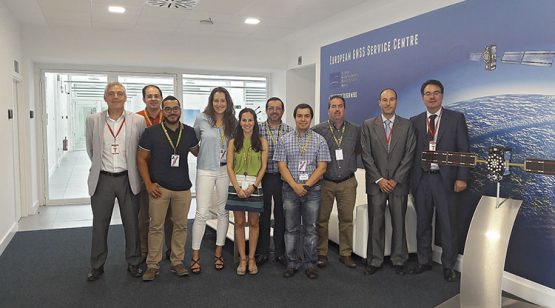Ineco’s technicians and engineers are working on projects, construction management and the provision of technical assistance for Adif and Adif Alta Velocidad, together with construction companies and other companies in the sector, for the modernisation of the conventional lines currently in operation and for the construction of the Madrid-Extremadura high-speed line, designed for passenger traffic with a maximum speed of 300 km/h and freight traffic up to 100 km/h.
The work is intense. In addition to having designed the Plasencia-Cáceres section, the company has been contracted for the management of platform works, track assembly, electrification, substations, removal of level crossings, noise protection, regulation of the effects on roads of the Regional Government of Extremadura, infrastructure conditioning, etc., all of which is essential for the trains to begin running on the new infrastructure. The doubling of the track between Cáceres and Mérida, the control, command and signalling installations, telecommunications, the electrification of the line and the remodelling of four stations on this route are the latest works in which Ineco is currently involved.

Most significant figures for the new infrastructure.
A route along the ancient Roman Silver Route
The Plasencia-Badajoz section, with a total length of 144.5 km, is the main axis of Phase 1 of the commissioning of the line. It has been designed with a platform for standard-gauge double track and mixed traffic, except for the Mérida-Badajoz section, which will be put into service with a single track. It passes through a large part of the province of Cáceres, on a route that in the section from Plasencia to Mérida runs parallel to the A-66 highway, the Ruta de la Plata, a modern testimony to a section of the ancient Roman road that crossed Extremadura from north to south.
The Tajo and Almonte viaducts, the latter having received several awards as the world’s longest arch-railway bridge, and the Santa Marina tunnel are the most notable individual works in this section. Experts from Ineco directed the work on this tunnel and are managing the works on the Plasencia, Cáceres, Mérida and Badajoz stations, for which they designed the remodelling projects.
Construction works: platform and track installation
The platform has been completed except for the sections of the Mérida bypass that are not included in Phase 1. In regard to track installation, the Mérida-Badajoz section has been completed, along with the installation of track 1 of the Cáceres-Mérida section, both in single track. The installation of the Plasencia-Cáceres section is more than 90% complete, and construction of Track 2 of the Cáceres-Mérida section began in February 2020.
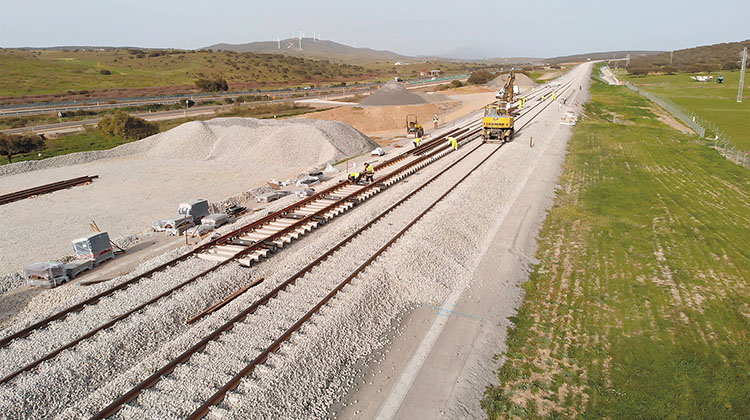
Track assembly work on the section between Plasencia and Cáceres in October 2019.
The technical construction challenges
The implementation of electric welding and the new method for rail unloading
Track installation involved the application of techniques that are rarely used in Spain, such as electric welding right on the track using mobile equipment, a procedure used with the high-speed line to Toledo and on the high-speed line between Makkah and Madinah in Saudi Arabia. This system produces higher quality, more durable welds than those produced by aluminothermic welding, aiming to achieve the goal of ‘zero maintenance’. The work is completely automated and if executed sequentially with stress neutralisation, both activities can be optimised.

In addition to the rail supplied by rail trains in 270-metre bars, rail in 108-metre bars was supplied on conventional platforms consisting of two sextets, which required the development of a new unloading procedure to optimise work performance.
The systematisation of the electric welding procedure with mobile equipment presented a major challenge. After supervising the execution of more than 1,400 welds and the subsequent performance analysis, the information gathered by Ineco made it possible to compare the technical work procedures associated with this activity with existing procedures. This experience could potentially lead to an improvement in projects and technical reference documents, in line with the company’s Strategic Plan ATENEA 2019-2022.
Unique infrastructures
Santa Marina, the longest tunnel on the line
The line between Plasencia and Badajoz has two tunnels totalling 4.4 kilometres in length, with 3.4 kilometres corresponding to the Santa Marina tunnel, in addition to its 1.5 kilometres of evacuation galleries. Located halfway between Plasencia and Cáceres, this tunnel crosses the Sierra de Santa Marina and is designed for high-speed double track and mixed traffic.

The Santa Marina tunnel crosses the regional Alentejo-Plasencia fault, one of the largest on the Iberian Peninsula. Ineco managed the construction of the 3.4 km tunnel that passes through the Los Castaños pass.
The tunnel was built using the New Austrian Method, has a waterproofing system that uses PVC membranes and a concrete lining. The waterproofing was done using an unconventional system, with sections of reinjectable double PVC membrane, to provide it with a high degree of watertightness to allow the recovery of the aquifer in the mountain range.
22 viaducts totalling over nine kilometres
The line has a total of 22 viaducts totalling more than nine kilometres. The most important viaducts are the ones crossing the Tajo and Almonte rivers in the section between Plasencia and Cáceres. The Almonte viaduct holds the world record for arch bridges and the Tajo viaduct is a close second in terms of span, with both representing outstanding feats of engineering.
The Almonte viaduct, awarded the prestigious Gustav Lindenthal Medal, crosses the reservoir using a long concrete arch with an upper deck and a main span 384 m long, making it the world’s longest high-speed concrete arch bridge.

In addition to the Almonte and Tajo River viaducts, the Vadetravieso viaduct, 1,596 metres long and crossing the river with the same name, is also worthy of note.
Designed by Spanish engineer Juan José Arenas and built by the Spanish-Portuguese consortium FCC Construcción-Conduril, this structure respects the habitat of the Alcántara reservoir, following the measures indicated in the EIS with maximum respect for the surroundings and the environment, including corrective measures to restore the environment and landscape and to facilitate the crossing of the infrastructure by the fauna. The viaduct also included the installation of innovative bird screens, which reduce wind thrusts on the structure, causing the birds to ascend in flight to avoid colliding with the trains.
Wildlife and ornithology reports
The richness of the natural habitat of the region of Extremadura, its pastureland and natural parks –including the Monfragüe, Cornalvo, and Los Barruecos natural parks– are areas of exceptional beauty and refuge for a multitude of birds and other species. From white storks to protected black storks, golden eagles, griffon vultures, kestrels, grey herons, spoonbills, and bustards, 74.1% of the territory of the Autonomous Community of Extremadura has been declared an Important Bird Area.
Ineco prepared monthly reports on the barrier effect on wildlife crossings and the effect on bird life in sensitive areas such as the Llanos de Cáceres y Sierra de Fuentes and the embalse de Alcántara special bird protections areas
The works pass through areas with different degrees of protection: A Special Bird Protection Area (SPA), a Site of Community Interest (SCI) –also known today as a Special Conservation Area (SCA)–, a Habitat of Community Interest and an IBA (Important Birds Area). Studies and preventive and corrective measures for the environmental impact were therefore required, which meant biological stops, population control reports, monitoring of the barrier effect, monitoring of lek mating areas, control of seeded crop areas, etc. Ridges were also built to protect wildlife, which uncovered an archaeological site with a building covering more than 500 square metres, an environment that was studied, catalogued and protected.

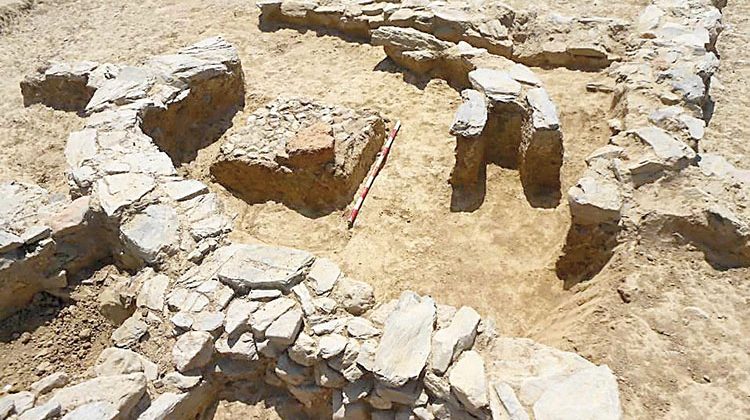

Electrification comes to Extremadura
Ineco is leading these works in the Plasencia-Badajoz-Portuguese
Border section, the first electrified section in this region, with the process to be continued in the future to connect to Madrid.
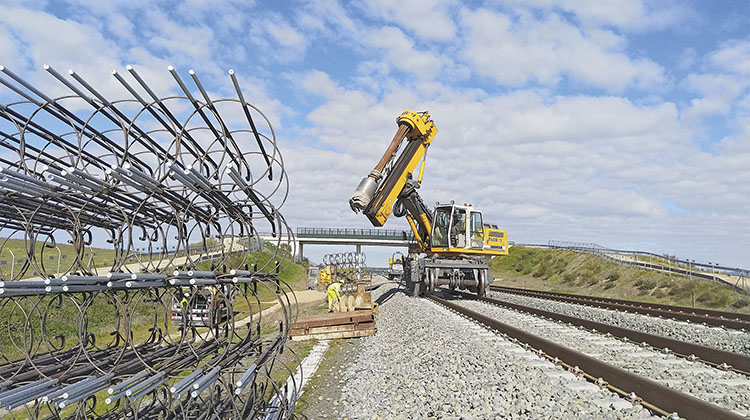
The excavation work, installation of rebar and pouring of foundations for the posts, gantries and overhead line anchors represented a milestone in the history of the Extremadura railway.
Extremadura was the only region in Spain without a single kilometre of electrified track; not for metro, tram, or conventional rail, let alone high speed. Work is currently progressing on the electrification of the Plasencia-Badajoz-Portuguese Border section, both on the overhead contact line and its associated systems and on the traction substations and transformer substations.
The overhead line catenary, designed by Ineco engineers, is an interoperable C-350 type overhead catenary system, suitable for running at 350 km/h, according to the regulations and specifically, the TSI for the energy subsystem and the UNE EN-50119 standard, which means that electric trains can run from Extremadura to Europe.
These works are being carried out on the 125-kilometre stretch between Plasencia and the Peñas Blancas split, approximately 15 kilometres north of Mérida. Approximately 4,200 catenary posts will be erected in this section, covering some 105 kilometres of double track and 20 kilometres of single track, with two railway stations: Plasencia and Cáceres.
The catenary works were divided into four areas, covering a total of 125 km of track
In addition, in regard to the conventional network that complements the high-speed network, work will be carried out on the Monfragüe-Plasencia line (between the Plasencia junction and Plasencia station), Madrid-Valencia de Alcántara (between the junction with the high-speed line section and Cáceres station) and on the Aljucén-Cáceres line (junction with the high-speed platform of the Cáceres-Aldea del Cano section and Cáceres station), as well as the southern branch of Cáceres. This project also includes the electrification of stations, sidings (PAET) and block stations (BP).
In the Plasencia station, tracks 1, 2 and 3 will be electrified, and in Cáceres station, tracks 1, 2, 5 and 7. The block stations will be electrified at the Terzuelo split and at KM 46/308, as well as at the Aldea del Cano PAET. Work and maintenance of the electric traction substations and auto-transformer substations on the Plasencia-Badajoz section is also underway. This work includes the energy installations required for the 2×25 kV electrification of the Plasencia-Badajoz section, which are mainly the Cañaveral (Cáceres), Carmonita and Sagrajas electricity substations (both in the province of Badajoz). In addition to these substations, there are a total of 12 associated auto-transformer substations.
Meanwhile, Adif has already started the bidding process for the electrification of the section between Mérida (Peñas Blancas) and Badajoz, which requires technical approval once it has passed the environmental procedures.
From phone blocks to Full Supervision
The renovation of the railway installations in the Plasencia-Cáceres and Mérida-Badajoz sections is combined with the implementation of the national network’s most efficient and advanced protection and traffic control systems on the new infrastructure in the Plasencia-Badajoz section. Ineco is providing the experience that it has acquired on high-speed lines in Spain to provide technical assistance for the traffic control installations.
The ultimate goal of the work on the control, command and signalling installations, for which Ineco is providing technical assistance to Adif Alta Velocidad, is to outfit the Plasencia- Badajoz-Portuguese Border section with the ERTMS Level 2 train protection system, which will make it possible to travel at the maximum commercial operating speed of 300 km/h in the region for the first time.
Previously, Extremadura had a single unelectrified track that still included routes with telephone blocking and mechanical interlocking, which is why the modernisation of the installations to adapt them to the new standards required on high-speed lines (unifying them with the new platform sections), poses a more than obvious challenge and constitutes the greatest technological leap forward undertaken in the railway sector at a national level.


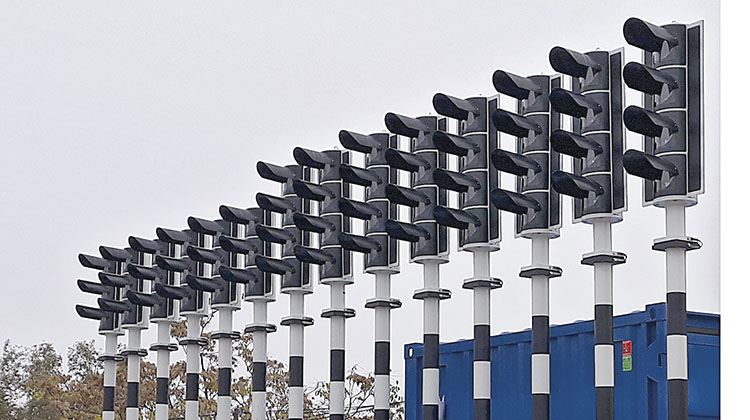
To guarantee this, an intermediate phase of renovation of the installations has been designed that will allow the Plasencia-Badajoz section to be put into operation under the protection of the digital ASFA system at a maximum speed of 200 km/h. This initial phase will result in a significant increase in safety, capacity and regularity of operation, since it will have double track along practically the entire route, eliminating telephone blocks and centralising control and management of the line at the Seville control centre.
The signalling installations are based on interlockings, together with their intermediate blocks, which allow the safe movement of the trains through the application of SIL 4 systems. The solution designed for the railway network on the Plasencia-Badajoz section has electronic interlockings based on Alstom’s Smartlock technology, with BAB and BLAU automatic block systems. In order to facilitate future maintenance, the interlockings are being upgraded. Some of the interlockings are electrical or even mechanical, as in the case of the Cañaveral or Aldea del Cano installations, which are still operated with a telephone block and will be replaced by a BAU type block. This equipment consists of six electronic interlockings located in Plasencia, Cañaveral RC, Cáceres, Mérida, Guadiana and Badajoz, supported by train detection systems installed in the field (Bombardier EBITRACK 400 coded audio frequency track circuits and Frauscher axle counters), Modular LED trackside signals from ICF, ASFA digital balises from Indra and Siemens MD2000 single-phase electric point machines to replace turnouts and derailers still equipped with manual switch stands, and Thales three-phase point machines for turnouts on the new platform.
The overpasses and tunnel entrances are equipped with Logytel Falling Object Detectors (FODs), which trigger trackside signals in the event of an alarm
Unlike other lines, the energy system designed in this project includes a main supply from the electricity company at all locations, using the overhead line as a backup system. This solution, combined with the inclusion of medium voltage networks as an alternative supply in certain sections, makes it possible to minimise the number of emergency power generator sets to be installed. This all results in a more stable, efficient and clean power supply, reaffirming the railway’s commitment to reducing greenhouse gas emissions.
These unique features, together with the particularly rich and protected environment, add to the complexity of Ineco’s work, which ranges from the drafting of the basic projects, environmental and expropriation documentation, inspection and testing of systems in the field, to the final supervision of the process of powering the installations, not to mention providing advice on the legalisation and contracting of the supplies.
Ineco is participating in the drafting of the basic projects, environmental documentation, expropriations, field tests, legal advice and final supervision
As a final complement, the deployment of the Bombardier ERTMS Level 2 system is planned for the installations of the new line between Plasencia, Cáceres and San Nicolás split, as well as on the line between Mérida and Badajoz. This train protection system is managed through two RBCs located in Cáceres and Badajoz, which are in constant communication with the electronic interlockings supported by the GSM-R mobile communications network, and grant movement authorisations to the trains on the lines that they protect.
The Santa Justa control centre in Seville will provide support for the centralised control and efficient operation of these installations. The Thales CTC will unify the remote control of the interlockings of lines L026 (Plasencia-Cáceres-San Nicolás split), L500 (Monfragüe-Casar de Cáceres triangle) and L520 (Villanueva de la Serena-Badajoz), which was previously distributed between the Chamartín and Manzanares CTCs. A new Bombardier ERTMS central control station will be responsible for controlling this train protection system, and a new Indra remote control for auxiliary detection systems will provide operators with all the necessary information regarding the falling-object detectors.
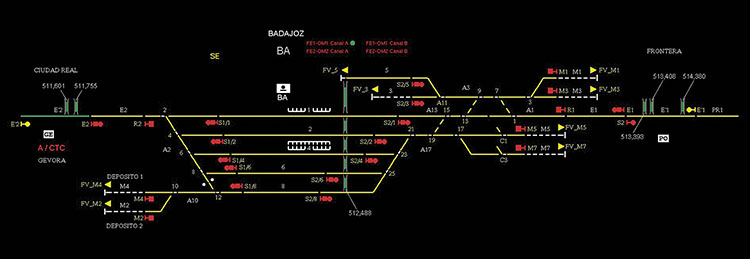
Videographic of the Badajoz station.
Correction: On page 14 of the print edition, the reference regarding the “province of Extremadura” should be “province of Cáceres”.
Modernisation of conventional lines

In parallel with the construction of the new line, Adif is also renovating its conventional lines, replacing material in some sections and refurbishing level crossings. The aim is to improve the track superstructure, unifying conditions to adapt them to the rail traffic demands. The work involves the improvement of the reliability, safety and quality of the track, reducing the level of incidents, increasing traffic speed and reducing travel times. In future editions of Ineco’s magazine, experts will describe the different conventional-track works being carried out, such as the completed works on the Aljucén-El Carrascalejo section, or the projects in the Monfragüe-Plasencia section that will soon be opened for tenders. Planned works include the renovation of the track superstructure, construction of walls, ballast retaining walls and service walkways, and platform drainage improvements.
New fixed and mobile installations
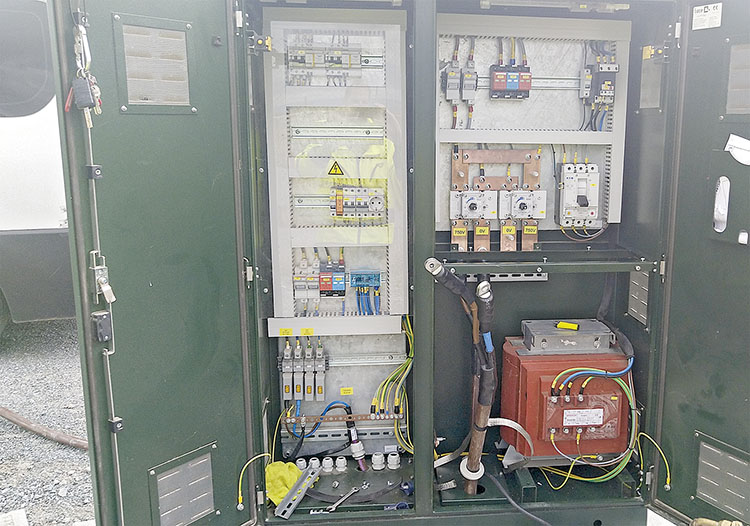
Work is currently underway on the Plasencia-Cáceres section. The civil works and laying of the optical fibre in the fixed telecommunications installations have been completed, as well as the civil works and installation of the mobile communications equipment between Cáceres and Badajoz. Other projects to be carried out after the commissioning of Phase 1 include:
- Renovation of the track between the Monfragüe and Plasencia stations.
- Doubling of the track between Mérida and Aljucén.
- Renovation of the track yard and accesses to the stations of Cáceres, Mérida, Aljucén and Badajoz.
- Connection of the Montijo station to the HSL.
- Reconfiguration of the splits at La Isla (Mérida) and San Nicolás (Badajoz).
- Remodelling and sustainable integration of the Navalmoral de la Mata station.
- Signalling and telecommunications installations on the doubling of the track in the Cáceres-Mérida section, final location of the Mérida bypass and renovation of the track yards at the stations.
- Logistics platforms in Mérida and Navalmoral de la Mata.






